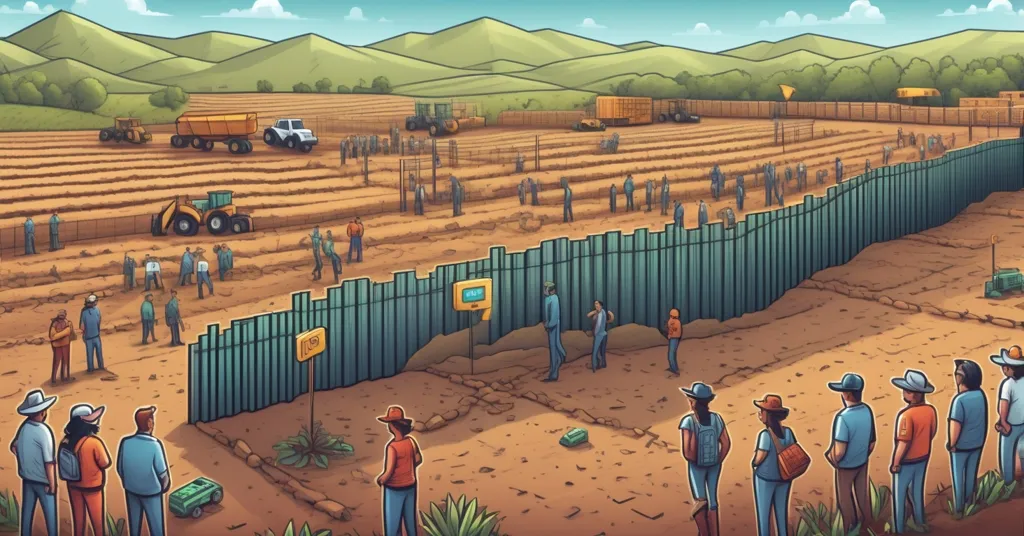Trump’s $150B Immigration Crackdown: Labor Crisis and Crypto Implications Unveiled

Trump’s $150 Billion Immigration Crackdown: A Labor Market Crisis with Hidden Crypto Implications
President Donald Trump’s $150 billion immigration enforcement push, known as the “Big Beautiful Bill,” is slashing the foreign-born workforce in the U.S. at a critical juncture, with 147,000 jobs added in June but labor shortages looming large. While the administration champions this as a victory for native workers, the economic fallout threatens industries from farming to crypto mining operations, raising urgent questions about whether such policies could stall both traditional and decentralized financial revolutions.
- Policy Fallout: Trump’s $150 billion initiative fuels border enforcement and deportations, shrinking the foreign-born labor pool for three straight months.
- Economic Threat: Experts predict GDP slowdowns and labor gaps, hitting key sectors like agriculture, hospitality, and even crypto infrastructure.
- Decentralized Angle: Could blockchain offer solutions to immigration and labor dilemmas while preserving security and freedom?
Let’s get straight to the point: the U.S. economy has relied on immigrant labor as its backbone for decades, especially in the grueling, low-wage sectors that keep society humming. Data from the Economic Policy Institute (EPI) reveals a staggering truth—over 95% of prime-age labor force growth since the 1990s comes from immigration. Without it, we’d have been dead in the water since 1994. Post-pandemic, foreign-born workers have been crucial, making up 39% of agriculture, 34% of construction, and 24% of hospitality workforces, often earning $16-17 an hour compared to the national median of $25. So, when Trump’s “Big Beautiful Bill”—a Senate-approved, $150 billion, four-year plan—ramps up border enforcement, mass deportations, and detention facilities, it’s not just a policy shift. It’s a direct blow to the labor market, with the foreign-born workforce shrinking for the third consecutive month even as the economy tacked on 147,000 jobs in June. For more on this aggressive enforcement plan, check out the details on Trump’s $150 billion immigration crackdown.
The Machinery of Enforcement
The scope of this crackdown is nothing short of staggering. We’re talking about beefed-up border patrols, a sharp drop in migrant encounters at the southwest border—effectively drying up a vital labor pipeline—and sprawling detention centers like Alligator Alcatraz in Florida, a 5,000-bed facility costing taxpayers $450 million a year to operate, partly funded by diverting resources from FEMA’s Shelter and Services program. Trump’s immigration czar, Tom Homan, pulls no punches on the intent behind this massive operation:
“We need more agents to arrest them. We need more beds to hold them. And we need more transportation contracts to move them out of the country.”
But while the border tightens, the economic cracks are widening. Industries that lean heavily on immigrant labor are sounding the alarm. Farmers and hospitality business owners have directly voiced their worries to Trump, and for good reason. When 40% of building and grounds maintenance workers and a third of construction crews are foreign-born, who steps in when they’re gone? The administration’s response, via Council of Economic Advisers Chair Stephen Miran, paints an optimistic picture of untapped native potential:
“There’s plenty of labor supply waiting to be brought in by the right incentives.”
Miran highlights high unemployment among young Americans—over 8% for those aged 20-24 and a brutal 14% for working-age teens—as evidence of a ready workforce. The proposed fix? Tax cuts on overtime to entice native workers into these roles. It’s a neat theory, but let’s be real—are teenagers and young adults, many eyeing tech careers or college degrees, going to swap their smartphones for shovels or aprons at below-median pay? For a deeper look at the broader effects of such policies, see this fact-checked analysis of Trump’s immigration remarks. The skepticism isn’t just anecdotal. Senior economist at Glassdoor, Daniel Zhao, lays it out plain:
“If the job market slows, then we should expect economic growth to follow.”
Federal Reserve Chair Jerome Powell doubles down on the warning, linking labor force growth to broader economic health:
“When you significantly slow the growth of the labor force, you will slow the growth of the economy. Growth will slow, and actually is slowing, and that’s one of the reasons.”
Numbers Don’t Lie: Economic Fallout on the Horizon
The data paints a grim picture. Deutsche Bank estimates the “breakeven rate” of job growth—the minimum needed to keep unemployment stable—could plummet to a mere 50,000 jobs per month, a steep fall from the stronger figures under Biden’s tenure. The American Enterprise Institute projects a GDP hit of 0.3 to 0.4 percentage points if net migration flatlines by 2025. For context, in a multi-trillion-dollar economy, that’s not a rounding error—it’s a shockwave. For more insights on this, explore the economic benefits of immigration to U.S. GDP. The Congressional Budget Office (CBO) piles on, noting that post-pandemic immigration surges boosted GDP by $8.9 trillion over a decade and slashed federal deficits by nearly $1 trillion through tax revenues. Slowing that inflow, they caution, could cripple long-term output.
Trump’s narrative adds another layer of contention. He’s dismissed labor gains under Biden as “fake,” driven by an “unchecked flow of undocumented immigrants.” During his tour of Alligator Alcatraz, he claimed each “illegal alien” costs taxpayers $70,000 over their lifetime, citing figures from the Center for Immigration Studies (CIS), a group known for its anti-immigration stance. But hold on—CBO and Cato Institute data tell a different story, with immigrants contributing nearly $1 trillion in taxes annually and often paying more into the system than they draw out. Economist Michael A. Clemens from George Mason University argues that even costs like public schooling for immigrant children yield long-term economic returns. So, are we saving pennies now only to lose dollars later, all while catering to a specific voter base? For a broader perspective on policy impacts, refer to this overview of Trump’s immigration policy framework.
Demographic Time Bomb and Industry Pain Points
Beyond the fiscal tug-of-war, there’s a deeper crisis brewing. EPI data shows that without immigration, growth in the U.S.-born prime-age labor force has been near zero for decades. With an aging population and shrinking birth rates, foreign-born workers aren’t just filling gaps—they’re the lifeline for future demands. Sectors like healthcare support are projected to need 250,000 more immigrants by 2032, while even tech fields like computer sciences rely on a 27% immigrant workforce. Picture a football team losing half its players with no bench to call on—that’s the U.S. labor market without sustained immigration. Curious about how these policies shape labor dynamics? Check out this discussion on immigration and labor markets.
Specific industries are already feeling the burn. In agriculture, where 39% of workers are foreign-born, farmers in regions like California’s Central Valley are struggling to harvest crops, potentially driving up food prices for everyday Americans. Hospitality, with 24% immigrant labor, faces similar staffing crunches—think hotels and restaurants unable to operate at full capacity. Construction, at 34% immigrant workforce, is seeing stalled projects due to empty job sites. These aren’t abstract stats; they’re the gears grinding to a halt in the real economy. For a focused look at these sector-specific struggles, see this analysis of labor shortages in farming and hospitality.
A Crypto Connection: Blockchain as a Disruptive Fix?
Now, let’s pivot to a perspective often overlooked in this debate—one that ties directly to our focus on decentralization and disruptive tech. The crypto and blockchain space, while not immediately associated with immigration, isn’t immune to labor shortages. U.S.-based crypto mining operations, for instance, rely on low-cost labor for facility maintenance, hardware setup, and cooling system management, roles often filled by foreign-born workers willing to take on physically demanding jobs at competitive wages. A shrinking workforce could hike operational costs, slowing the growth of Bitcoin mining hubs in states like Texas or Kentucky, and ultimately impacting the decentralized financial ecosystem we champion. Community discussions highlight similar concerns; take a look at this Reddit thread on immigration policy and labor in crypto mining.
But there’s a flip side—blockchain technology could offer a radical solution to the immigration-labor conundrum. Decentralized identity systems, built on blockchain, could streamline legal immigration pathways by providing secure, tamper-proof verification of worker credentials and backgrounds. This would align with our ethos of privacy and freedom, cutting through bureaucratic red tape while addressing security concerns. Imagine a system where a farmer in need of seasonal workers or a crypto mining firm seeking technicians could access a global talent pool via a decentralized platform, bypassing centralized visa bottlenecks. It’s not a pipe dream—projects like Self-Sovereign Identity (SSI) protocols on Ethereum or Bitcoin-inspired trust networks are already laying the groundwork. For more on this innovative approach, explore how blockchain can address labor and immigration crises. Could redirecting a fraction of that $450 million spent on facilities like Alligator Alcatraz toward blockchain-based immigration tech balance enforcement with economic need?
Counterpoints and Hard Realities
To give credit where it’s due, the administration’s push for native labor isn’t entirely baseless. Historical programs, like tax incentives during post-WWII labor shortages, have occasionally lured domestic workers into underrepresented roles. If tailored correctly—say, with targeted training programs alongside overtime tax cuts—there’s potential to mobilize portions of the 8% unemployed 20-to-24-year-olds into critical sectors. Some economists also argue that reducing reliance on foreign labor could, over time, force wage increases in low-paying industries, benefiting native workers. But the timeline for such adjustments is the kicker. Industries need workers now, not in a decade when cultural or economic shifts might take hold.
On the flip side, the risk of political overreach looms large. Trump’s inflated claims, like doubling Biden-era migrant arrivals to 21 million, and reliance on contested CIS data could erode trust among moderates and industry leaders already grappling with empty fields and factories. Are we building a wall around our economy while securing the border? The $150 billion question isn’t just about enforcement costs—it’s about whether we’re willing to trade short-term political wins for long-term economic pain.
Key Questions and Takeaways on Trump’s Immigration Crackdown
- How is Trump’s $150 billion immigration policy impacting the U.S. labor market?
It’s reducing the foreign-born workforce, causing labor shortages despite 147,000 new jobs in June, and threatening industries reliant on immigrant workers. - Can native-born Americans realistically replace immigrant labor in key sectors?
The administration hopes incentives like overtime tax cuts will draw in native workers, but economists doubt young Americans will fill low-wage, labor-intensive roles at scale. - What are the long-term economic risks of slashing immigration?
Experts forecast a GDP drop of 0.3-0.4% if migration stalls by 2025, with job growth potentially falling to 50,000 per month, signaling a significant slowdown. - Which industries face the biggest challenges from these labor shortages?
Agriculture (39% immigrant workforce), hospitality (24%), construction (34%), and even crypto mining operations are struggling with staffing crises that could ripple into higher costs. - Could blockchain technology offer a solution to immigration and labor issues?
Decentralized identity systems on blockchain could streamline legal worker pathways, balancing security with economic needs, and supporting industries like crypto mining reliant on global talent.



